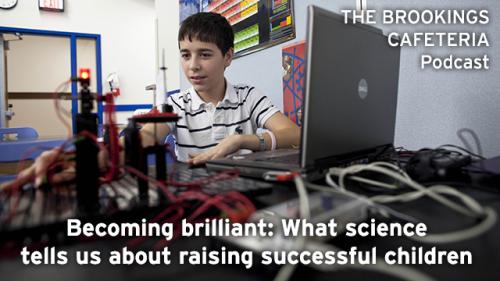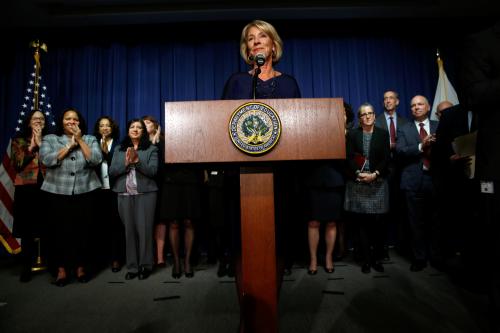“My administration wants to work with members of both parties to make child care accessible and affordable” —President Trump at Joint Session of Congress March 1, 2017
Support for young children and families is on the national and global agenda. On October 5, 2016, Dr. Margaret Chan of the United Nations World Health Organization noted, “Investing in young children is a moral, economic, and social imperative.” This statement ushered in the U.N. Sustainable Development Goals in early education. In his address to the Joint Session of Congress, President Trump echoed this imperative. And in the U.S., interest in early childhood is one area that enjoys bipartisan support.
Strong evidence of the powerful long-term impacts on development from classic early childhood interventions like the Abecedarian Project, Perry Preschool Program, and Chicago Child-Parent Centers have prompted a new generation of large-scale preschool interventions. Although this new wave of preschool studies has been effective in boosting school readiness at kindergarten entry, there is evidence that initial gains are dissipating over the course of elementary school. These “fade-out” or “catch-up” effects are inciting heated debate in the field of early childhood education on whether the new generation of larger-scale preschool programs can generate the long-term impacts of the original smaller scale, more intensive interventions.
Some critics go as far as citing the mixed medium-term results of the latest round of preschool interventions as grounds for disinvestment. We believe that it is premature to draw such conclusions before evaluating the long-term results. Indeed, a broader historical perspective reveals that the latest studies mirror the results of the first-generation of interventions. The Abecedarian, Perry, and Chicago Child-Parent programs all demonstrated immediate impacts on child outcomes upon program completion; however, before the long-term effects on educational attainment, earnings, crime, and adult health that have received the most attention—there were mixed results on sustained effects of cognitive and academic outcomes during elementary and middle school in all three programs. In fact, this pattern of short-term impacts, mixed intermediate results, followed by positive long-term effects is pervasive in the literature.
For example, a 2009 study of Head Start found positive effects on test scores at ages 5-10, but no effects for 11-14 year olds. Long-term, however, children served by Head Start experienced less grade retention, higher high-school graduation, and better physical health in young adulthood than their siblings who did not attend Head Start. Similarly, the NICHD Study of Early Care found effects of child care quality and center-based care prior to kindergarten—these effects weakened over the course of elementary school—but still predicted higher cognitive-academic achievement at age 15, as well as, class rank, grades, and college admission. The recent preschool studies in Boston, New Jersey, Oklahoma, and Tennessee are still in line with this pattern of results. They all demonstrated positive short-term impacts with more mixed results in the intermediate timeframe. As of yet, none of them have been able to examine the long-term results because participants are not yet adults. It is imperative that as a field we continue to conduct follow-up studies to assess the results of programs years and decades after they finish.
While we await these long-term results, we do not have to sit idly by, hands tied. A half century of early childhood research tells us where to focus our attention—improvement of the quality of early education and care. An important starting place is strengthening and supporting the early childhood education workforce. How?
First, pay early childhood teachers a living wage. Infant toddler teachers are paid in the bottom 3 percent of all workers; preschool teachers are in the 19th percentile. Consequently, teacher stress and depression are growing problems in the early childhood workforce negatively affecting child outcomes.
Second, attract and retain highly educated teachers. Less than 20 percent of infant and toddler teachers hold a bachelor’s degree, which rises to 45 percent for preschool teachers. Furthermore, the annual turnover rate for lead teachers in Head Start is 25 percent compared to 8 percent among K-3 teachers. Children have a harder time learning and creating attachments when caregivers come and go.
Last, provide ongoing support for early childhood teachers to improve on the job. Personalized feedback from an expert coach is a powerful tool for improving the quality of teachers-child interactions; while one-on-one coaching can be expensive, web-mediated platforms allow coaches an expanded reach at a reduced cost.
Another thing we can do is start earlier and involve parents. Research affirms that programs targeting children and parents in the 0-3 age range show powerful and lasting results. The Nurse-Family Partnership and the Infant Health and Development Program both produced lifelong benefits for children through home visiting and coaching of parenting skills for low-income mothers during the first three years of their babies’ lives. Additionally, better alignment between preschool and K-3 curricula may reduce “fade-out” effects. Recent evidence supports that children who enter kindergarten with an initial advantage from preschool do not progress when kindergarten and first grade focus on skills that children have already mastered. Instead, elementary schools need to build on and expand the math and literacy skills that children are acquiring in high quality early childhood programs.
Is the current iteration of preschool perfect? No. Will it have long-term benefits the same way that the classic preschool interventions did? Too soon to tell. Do our nation’s children need access to high quality early childhood education? Yes, and too many are not getting it. So while we wait to see if recent preschool efforts have long-term impacts, we must continue to improve programs for the children and families they serve. Supporting and educating teachers, expanding services across the 0-5 age range for children and their parents, and assuring better alignment of instruction between preschool and early elementary are ideal places to start. High quality early childhood education sets children on life trajectories of success. As a society, the chance to provide these powerful services is one we cannot afford to pass up.
The Brookings Institution is committed to quality, independence, and impact.
We are supported by a diverse array of funders. In line with our values and policies, each Brookings publication represents the sole views of its author(s).














Commentary
Realizing the promise of high quality early childhood education
March 27, 2017